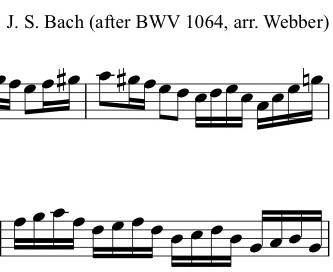HIP hip
April 2010
"Originality is nothing but judicious imitation." - Voltaire
"Originality is undetected plagiarism." - William Ralph Inge
In the 20th century, the legal protection of copyright became big business, particularly in zealously-litigious Anglo-Saxon societies, fond of words such as plagiarism, infringement and paternity. Ironically, lawyers defending cases of plagiarism often show that offending passages can be found in existing out-of-copyright ("public domain") works, and are therefore not that original anyway. Ethics aside, melodies and harmonies that touch the human heart have been around since there were hearts to touch. There’s a reason why cliches become cliches.
In 1791, W.A. Mozart would not have died in poverty had he received some payment every time his works were performed; whereas nowadays, technically, we commit copyright infringement by singing Happy Birthday without acknowledging Hill/Hill, registering the performance and paying royalties.
Before the "information age", aural tradition and memorisation were how a great deal of material, musical or otherwise, was spread and passed down through generations.
Along with their stock of compulsory chorale tunes and "standard" affects, composers would also adapt or borrow directly from the works of others and think nothing of putting their own name to the "new" piece. A particularly cheeky example of this would be Moravian composer PJ Vejvanovsky. Research has shown that many of "his" works, which appeared in the library where he worked in later life, were simply copied directly from other composers, including one that was written when he was just three years old.
Composers would also "recycle" their own material. J.S. Bach arranged pieces by Vivaldi and rearranged several of his own works for different settings or occasions Ð Was Gott tut, das ist wohlgetan, for instance, received many treatments and the B-Minor Mass (BWV 232) is mostly compiled of modified movements from his cantatas. You may recognise one of those today in BWV12, performed first in Weimar and again in Leipzig. There was a difference in performing pitch between these two towns (Chorton and Kammerton - "high" and "low" respectively- a difference of a whole tone) and without allowing for this, BWV12 is, to quote Piet Dhont, "extremely uncomfortable" to play to on a Baroque oboe.
Because we’re playing the Leipzig setting, Piet and "Super" Mario Topper have lovingly transposed the parts (which Bach did to other re-performed cantatas) to their original sounding pitch (from F dorian/Bb to G dorian/C), giving the oboe a more characteristic part. In Weimar, the new-fangled, "French" oboe, pitched in Kammerton, would have been played in this key anyway.
Much in the same way that G.F. Handel’s Concerti for Organ (Opus 4) were re-written versions of his earlier instrumental sonatas, Oliver Webber’s arrangement of Concerto for Three Harpsichords (BWV1064) for three solo violins (and ripieno) is a natural and historic adaptation of a piece that may even have been conceived for this combination in the first place and then lost. Other such reconstructions have been made but this is the one we prefer; and in our "Premieres" season, it was another chance to work with a living writer, who just happens to be one of our favourite musicians.
Mike Diprose
April 2010
Nederlandse samenvatting
Naast choraalmelodieën en standaard "affecten" gebruikten componisten in de barok ook muziek van andere componisten. En ze hergebtuikten hun eigen werk.
J.S. Bach arrangeerde stukken van Vivaldi maar bewerkte ook veel van zijn eigen muziek voor nieuwe gelegenheden - van Was Gott tut, das ist wohlgetan bestaan bijvoorbeeld meerdere versies en de Hohe Messe (BWV 232) is voor het grootste deel samengesteld uit bewerkingen van delen uit eerder geschreven cantates. Het koordeel in cantate BWV 12 bijvoorbeeld.
BWV 12 werd voor het eerst uitgevoerd in Weimar en later nog een keer in Leipzig. In Weimar was de toonhoogte een toon hoger in Leipzig (het verschil tussen Chorton en Kammerton) en als men dat verschil in toonhoogte vergeet is in de hobo partij BWV12, in de woorden van Piet Dhont, "extreem ongemakkelijk" op barokhobo te spelen.
Piet en Mario Topper hebben de partijen getransponeerd naar hun oorspronkelijk klinkende toonhoogte (zoals Bach zelf met andere cantates deed die hij in Leipzig hernam).
Een ander voorbeeld van bewerkingen zijn G.F. Handels Concerti voor Orgel (Opus 4); herschreven versies van vroegere instrumentale sonates. In diezelfde traditie heeft Oliver Webber van Bachs Concerto voor drie Clavecimbels (BWV1064) een bewerking gemaakt voor drie solo violen (en ripieno). Er bestaan andere versies van dit concert, maar wij geven de voorkeur aan deze, omdat we hierdoor in ons seizoen met "Premieres" n—g een kans hebben met een levende componist te kunnen werken, die toevallig tevens ŽŽn van onze favoriete musici is.
|
